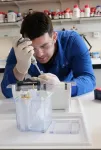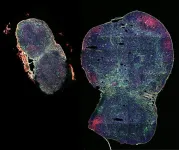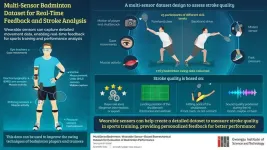(Press-News.org) KEY TAKEAWAYS
BRILLIANCE trial results showed 11 out of 14 treated participants experienced some improvements in vision and quality of life measures.
CRISPR-based therapy was found safe with no dose-limiting toxicities reported.
Mass Eye and Ear researchers say their findings support continued research and clinical trials of CRISPR therapies for inherited retinal disorders.
BOSTON- (MAY 6, 2024) Results from a groundbreaking clinical trial of CRISPR gene editing in 14 individuals with a form of inherited blindness show that the treatment is safe and led to measurable improvements in 11 of the participants treated. The phase 1/2 trial called BRILLIANCE, was led by principal investigator Eric Pierce, MD, PhD, of Mass Eye and Ear, a member of the Mass General Brigham healthcare system, and sponsored by Editas Medicine, Inc. Findings are reported May 6th in The New England Journal of Medicine.
“This research demonstrates that CRISPR gene therapy for inherited vision loss is worth continued pursuit in research and clinical trials,” said Pierce, director of Ocular Genomics Institute and Berman-Gund Laboratory for the Study of Retinal Degenerations at Mass Eye and Ear and Harvard Medical School. “While more research is needed to determine who may benefit most, we consider the early results promising. To hear from several participants how thrilled they were that they could finally see the food on their plates –that is a big deal. These were individuals who could not read any lines on an eye chart and who had no treatment options, which is the unfortunate reality for most people with inherited retinal disorders.”
All 14 trial participants, including 12 adults (ages 17 to 63) and two children (ages 10 and 14), were born with a form of Leber Congenital Amaurosis (LCA) caused by mutations in the centrosomal protein 290 (CEP290) gene. They underwent a single injection of a CRISPR/Cas9 genome editing medicine, EDIT-101 in one eye via a specialized surgical procedure. This trial, which included the first patient to ever receive a CRISPR-based investigational medicine directly inside the body, focused primarily on safety with a secondary analysis for efficacy.
No serious treatment or procedure-related adverse events were reported, nor were there any dose-limiting toxicities. For efficacy, the researchers looked at four measures: best-corrected visual acuity (BCVA); dark-adapted full-field stimulus testing (FST), visual function navigation (VNC, as measured by a maze participants completed), and vision-related quality of life.
Eleven participants demonstrated improvements in at least one of those outcomes, while six demonstrated improvement in two or more. Four participants had clinically meaningful improvement in BCVA. Six participants experienced meaningful improvements in cone-mediated vision as indicated by FSTs, five of whom had improvements in at least one of the three other outcomes. Cone photoreceptors are used for daytime and central vision.
“The results from the BRILLIANCE trial provide proof of concept and important learnings for the development of new and innovative medicines for inherited retinal diseases. We’ve demonstrated that we can safely deliver a CRISPR-based gene editing therapeutic to the retina and have clinically meaningful outcomes,” said Baisong Mei, MD, PhD, Chief Medical Officer, Editas Medicine.
Studies like this one show the promise of gene therapy for treating incurable conditions. Mass General Brigham’s Gene and Cell Therapy Institute is helping to translate scientific discoveries made by researchers into first-in-human clinical trials and, ultimately, life-changing treatments for patients.
Exploring CRISPR as an inherited retinal disorder treatment
Mutations in the CEP290 gene are the leading cause of inherited blindness taking place during the first decade of life. The mutations cause rod and cone photoceptors in the eye’s retina to function improperly, which after some time will lead to irreversible vision loss. Pierce compares it to a small part of an engine breaking down, which eventually leads the entire engine to falter.
CRISPR-Cas9 is a gene editing toolkit that acts as a GPS-guided scissor to cut a portion of the mutated genome to leave a functional gene. For inherited blindness, the goal was to inject CRISPR to reach the eye’s retina to restore the ability to produce the gene and protein responsible for light-sensing cells.
The CEP290 gene is larger than what traditional adeno-associated virus (AAV) vector gene therapies, including one FDA-approved for a different type of inherited vision loss, can accommodate. The genome editing company Editas Medicine began exploring how to tackle the CEP290 mutation in 2014, conducting preclinical studies to determine whether a gene editing approach like CRISPR-Cas9 might be feasible to target these large gene mutations. This work led to the BRILLIANCE trial, which began in mid-2019.
The first patient to receive a CRISPR treatment inside the body (in vivo) took place at the Casey Eye Institute at Oregon Health & Science University (OHSU), under the leadership of Mark Pennesi, MD, PhD.
“This trial shows CRISPR gene editing has exciting potential to treat inherited retinal degeneration,” Pennesi said. “There is nothing more rewarding to a physician than hearing a patient describe how their vision has improved after a treatment. One of our trial participants has shared several examples, including being able to find their phone after misplacing it and knowing that their coffee machine is working by seeing its small lights. While these types of tasks might seem trivial to those who are normally sighted, such improvements can have a huge impact on quality of life for those with low vision.”
The second patient was treated at Mass Eye and Ear in September 2020, following delays caused by the COVID-19 pandemic. Additional participants were treated across three other trial sites: Bascom Palmer Eye Institute, W.K. Kellogg Eye Center, and Scheie Eye Institute at the Children’s Hospital of Philadelphia (CHOP) and the Hospital of the University of Pennsylvania. Two adults received low-dose therapy, five received mid-dose, and another five received a high-dose treatment. Two children, treated at CHOP under the leadership of Tomas S. Aleman, MD, received a mid-dose treatment.
“Our patients are the first congenitally blind children to be treated with gene-editing, which significantly improved their daytime vision. Our hope is that the study will pave the road for treatments of younger children with similar conditions and further improvements in vision,” said Aleman, the Irene Heinz-Given and John LaPorte Research Professor in Ophthalmology at Penn Medicine with the Scheie Eye Institute and a pediatric ophthalmologist at CHOP who served as a site principal investigator and study co-author. “This trial represents a landmark in the treatment of genetic diseases, in specific, genetic blindness, by offering an important alternative treatment, when traditional forms of gene therapy, such as gene augmentation, are not an option.”
Participants were monitored every three months for one year, and then followed less frequently for two additional years. At visits, they would undergo a series of serum and vision tests to examine safety and efficacy outcome measures.
In November 2022, Editas paused enrollment on the BRILLIANCE trial. Pierce and colleagues are exploring working with other commercial partners to conduct additional trials, in collaboration with Editas. The researchers hope future studies can examine ideal dosing, whether a treatment effect is more pronounced in certain age groups such as younger patients, and include refined endpoints to measure the effects of improved cone function on activities of daily living.
Authorship: The senior corresponding author of this study was Eric A. Pierce, MD, PhD (Mass Eye and Ear), and Tomas S. Aleman, MD (CHOP) and Mark E. Pennesi, MD, PhD (OHSU) were co-corresponding authors. Additional co-authors include Kanishka T. Jayasundera, MD (Kellogg), Bright S. Ashimatey, OD, PhD (Editas), Keunpyo Kim, PhD (Editas), Alia Rashid, MD (Editas), Michael C. Jaskolka, PhD (Editas), Rene L. Myers, PhD (Editas), Byron L. Lam, MD (Bascom Palmer), Steven T. Bailey, MD (OHSU), Jason I. Comander, MD, PhD (Mass Eye and Ear), Andreas K. Lauer, MD (OHSU), Albert M. Maguire, MD (CHOP).
Disclosures: Disclosure forms provided by the author are available with the full text of the journal article at NEJM.org
Funding: This research was funded by Editas medicine. This research was also supported by the National Institute of Health P30 EY014104 core grant to Mass Eye and Ear, P30 EY010572 core grant, the Malcolm M. Marquis MD Endowed Fund for Innovation, and an unrestricted grants from Research to Prevent Blindness to Casey Eye Institute and the Scheie Eye Institute. Additional support was provided by the Irene Heinz Given and John La Porte Given Endowment, and Hope for Vision.
Paper cited: Pierce, EA et al. “Gene-editing for CEP290-associated Retinal Degeneration” NEJM DOI: 10.1056/NEJMoa2309915.
###
About Mass Eye and Ear
Massachusetts Eye and Ear, founded in 1824, is an international center for treatment and research and a teaching hospital of Harvard Medical School. A member of Mass General Brigham, Mass Eye and Ear specializes in ophthalmology (eye care) and otolaryngology–head and neck surgery (ear, nose and throat care). Mass Eye and Ear clinicians provide care ranging from the routine to the very complex. Also home to the world's largest community of hearing and vision researchers, Mass Eye and Ear scientists are driven by a mission to discover the basic biology underlying conditions affecting the eyes, ears, nose, throat, head and neck and to develop new treatments and cures. In the 2023–2024 “Best Hospitals Survey,” U.S. News & World Report ranked Mass Eye and Ear #4 in the nation for eye care and #7 for ear, nose and throat care. For more information about life-changing care and research at Mass Eye and Ear, visit our blog, Focus, and follow us on Instagram, Twitter and Facebook.
END
CRIPSR gene editing leads to improvements in vision for people with inherited blindness, clinical trial shows
Mass Eye and Ear-led phase 1/2 trial, which included 14 participants, found that the first-of-its-kind experimental treatment was safe and efficacious
2024-05-06
ELSE PRESS RELEASES FROM THIS DATE:
Improvement seen in most participants of pioneering CRISPR gene editing trial
2024-05-06
PORTLAND, Oregon – About 79% of clinical trial participants experienced measurable improvement after receiving experimental, CRISPR-based gene editing that is designed to fix a rare form of blindness, according to a paper published in the New England Journal of Medicine.
“This trial shows CRISPR gene editing has exciting potential to treat inherited retinal degeneration,” said Mark Pennesi, M.D., Ph.D., a corresponding author on the paper, an ophthalmologist and Oregon Health & Science University’s lead scientist for the Phase ...
Cybersecurity education varies widely in US
2024-05-06
PULLMAN, Wash. -- Cybersecurity programs vary dramatically across the country, a review has found. The authors argue that program leaders should work with professional societies to make sure graduates are well trained to meet industry needs in a fast-changing field.
In the review, published in the Proceedings of the Association for Computing Machinery’s Technical Symposium on Computer Science Education, a Washington State University-led research team found a shortage of research in evaluating the instructional approaches being used to teach cybersecurity. The authors also contend that programs ...
New vaccine effective against coronaviruses that haven’t even emerged yet
2024-05-06
Researchers have developed a new vaccine technology that has been shown in mice to provide protection against a broad range of coronaviruses with potential for future disease outbreaks - including ones we don’t even know about.
This is a new approach to vaccine development called ‘proactive vaccinology’, where scientists build a vaccine before the disease-causing pathogen even emerges.
The new vaccine works by training the body’s immune system to recognise specific regions of eight different coronaviruses, including SARS-CoV-1, SARS-CoV-2, and several that are ...
Simulated chemistry: New AI platform designs tomorrow’s cancer drugs
2024-05-06
Scientists at UC San Diego have developed a machine learning algorithm to simulate the time-consuming chemistry involved in the earliest phases of drug discovery, which could significantly streamline the process and open doors for never-before-seen treatments. Identifying candidate drugs for further optimization typically involves thousands of individual experiments, but the new artificial intelligence (AI) platform could potentially give the same results in a fraction of the time. The researchers used the new tool, described in Nature Communications, to synthesize 32 new drug candidates for cancer.
The technology is part of a new but growing trend ...
Human ‘neural compass’ pinpointed in new study
2024-05-06
A pattern of brain activity that helps prevent us from getting lost has been identified in a new study, published in Nature Human Behaviour.
Researchers at the University of Birmingham and Ludwig Maximilian University of Munich have for the first time been able to pinpoint the location of an internal neural compass which the human brain uses to orientate itself in space and navigate through the environment.
The research identifies finely tuned head direction signals within the brain. The results are comparable to neural codes identified in ...
Personalized screening early in pregnancy may improve preeclampsia detection
2024-05-06
Research Highlights:
A personalized screening algorithm for preeclampsia in the first trimester of pregnancy may help clinicians better predict who is at risk for developing the condition and who may benefit from treatment with a daily, low-dose aspirin.
In this study of more than 7,000 women, the new screening method, which combined maternal history, biomarker tests and ultrasound tests, was better at identifying preeclampsia risk in than current risk factor-based guidelines.
Embargoed until 4 a.m. CT/5 a.m. ET Monday, May 6, 2024
DALLAS, May 6, 2024 — A new screening algorithm for preeclampsia combining maternal history, ...
Expanding a lymph node, boosting a vaccine
2024-05-06
Expanding a lymph node, boosting a vaccine
A biomaterial vaccine enhances and sustains lymph node expansion following vaccination, boosting anti-tumor immunity in an animal model.
By Benjamin Boettner
(BOSTON) — Each one of us has around 600 lymph nodes (LNs) – small, bean-shaped organs that house various types of blood cells and filter lymph fluid – scattered throughout our bodies. Many of us have also experienced some of our LNs to temporarily swelling during infections with viruses or other pathogens. This LN expansion and subsequent contraction can also result from vaccines injected nearby, and in fact ...
GIST-MIT CSAIL researchers develop a biomechanical dataset for badminton performance analysis
2024-05-06
In sports training, practice is the key, but being able to emulate the techniques of professional athletes can take a player’s performance to the next level. AI-based personalized sports coaching assistants can make this a reality by utilizing published datasets. With cameras and sensors strategically placed on the athlete's body, these systems can track everything, including joint movement patterns, muscle activation levels, and gaze movements.
Using this data, personalized feedback is provided on player technique, along with improvement recommendations. Athletes can access this feedback anytime, and anywhere, making these systems versatile for athletes at ...
Study sheds light on 11th century Arab-Muslim optical scientist whose work laid ground for modern-day physics
2024-05-06
Scientists from the University of Sharjah and the Warburg Institute are poring over the writings of an 11th century Arab-Muslim polymath to demonstrate their impact on the development of optical sciences and how they have fundamentally transformed the history of physics from the Middle Ages up to modern times in Europe.
Their research focuses on the legacy of al-Ḥasan Ibn al-Haytham known in Latin as “Alhazen” and particularly his most influential work titled Book of Optics, reputed in Arabic as Kitab al-Manazir and first circulated in Europe via its Latin translation dubbed ‘Perspectiva’. Ibn ...
Rethinking “socially admitted” patients
2024-05-06
Labelling vulnerable patients in hospital as “socially admitted” may prevent treatment of medical issues, according to new research in CMAJ (Canadian Medical Association Journal) https://www.cmaj.ca/lookup/doi/10.1503/cmaj.231430.
Emergency departments are the last resort for some socially vulnerable people who may not have an acute or new medical issue. They may be seeking care because of a breakdown of supports or the inability of the patient, or their family, to cope with living at home. These people are known colloquially as “social admissions,” and other labels such as “orphan patient,” “failure ...
LAST 30 PRESS RELEASES:
University of Oklahoma researcher awarded funding to pursue AI-powered material design
Exploring how the visual system recovers following injury
Support for parents with infants at pediatric check-ups leads to better reading and math skills in elementary school
Kids’ behavioral health is a growing share of family health costs
Day & night: Cancer disrupts the brain’s natural rhythm
COVID-19 vaccination significantly reduces risk to pregnant women and baby
The role of vaccination in maternal and perinatal outcomes associated with COVID-19 in pregnancy
Mayo Clinic smartwatch system helps parents shorten and defuse children's severe tantrums early
Behavioral health spending spikes to 40% of all children’s health expenditures, nearly doubling in a decade
Digital cognitive behavioral treatment for generalized anxiety disorder
Expenditures for pediatric behavioral health care over time and estimated family financial burden
Air conditioning in nursing homes and mortality during extreme heat
The Alps to lose a record number of glaciers in the next decade
What makes a good proton conductor?
New science reporting guide published for journalists in Bulgaria
New international study reveals major survival gaps among children with cancer
New science reporting guide published for journalists in Turkey
Scientists develop a smarter mRNA therapy that knows which cells to target
Neuroanatomy-informed brain–machine hybrid intelligence for robust acoustic target detection
Eight SwRI hydrogen projects funded by ENERGYWERX
The Lundquist Institute and its start-up company Vitalex Biosciences Announces Strategic Advancement of Second-Generation fungal Vaccine VXV-01 through Phase 1 Trials under $40 Million Competitive Con
Fine particles in pollution are associated with early signs of autoimmune disease
Review article | Towards a Global Ground-Based Earth Observatory (GGBEO): Leveraging existing systems and networks
Penn and UMich create world’s smallest programmable, autonomous robots
Cleveland researchers launch first major study to address ‘hidden performance killer’ in athletes
To connect across politics, try saying what you oppose
Modulating key interaction prevents virus from entering cells
Project explores barriers to NHS career progression facing international medical graduates
Jeonbuk National University researchers explore the impact of different seasonings on the flavor perception of Doenjang soup
Two Keck Medicine of USC Hospitals named Leapfrog Top Teaching Hospitals
[Press-News.org] CRIPSR gene editing leads to improvements in vision for people with inherited blindness, clinical trial showsMass Eye and Ear-led phase 1/2 trial, which included 14 participants, found that the first-of-its-kind experimental treatment was safe and efficacious







